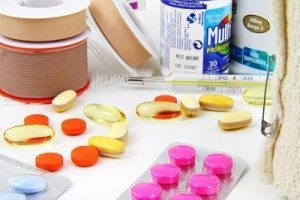Quick question here. What is one item that every driver and every camper should have with them? The answer? It is a survival and a first aid kit.
Whether you get stranded on the side of a road or are facing an injury or a medical emergency out on a trail, you need to be prepared. Building a survival and first aid kit yourself ensures that you are aware of what is in the kit. Make sure you know how to use the contents of your kit before you are all packed up and out in the wilderness.
1. Pack For The Terrain
 Every environment will have unique challenges and potential hazards that are not found everywhere else. Before you go off into the mountainous grassland, you may want to find out whether there are snakes or not. After all, maybe where you live you have to deal with crocodiles but have never seen any snakes. Depending upon where you are traveling learn the local snakes and what types of snake poison kits there are to deal with bites.
Every environment will have unique challenges and potential hazards that are not found everywhere else. Before you go off into the mountainous grassland, you may want to find out whether there are snakes or not. After all, maybe where you live you have to deal with crocodiles but have never seen any snakes. Depending upon where you are traveling learn the local snakes and what types of snake poison kits there are to deal with bites.
In addition, if you or anyone in your party takes any medications on a regular basis, make sure a fresh prescription is with you on the road too.
2. Bring along plenty of antiseptic to clean wounds.
Peroxide and iodine ampules work well. Antiseptic wipes are good to obtain as well, though if a cut goes deep, you will want to be able to rinse out the cut. In addition, have many bandages as well, including of all things a roll of duct tape. While duct tape may be useful for other aspects of setting up a camp, duct tape plays one main and major role in wound care.
It is an excellent way to seal a wound once you have debrided the cut. Always bring along those little butterfly-shaped bandages. They are great for pulling the skin back together on a small cut or wound, which helps to ensure better healing while ensuring dirt does not get into the cut.
3. Along the lines of oral medication, bring along an oral antibiotic.
 Some doctors will provide a prescription for emergency kits while others may not. Though, if you will be in the wild for a while, it can help immensely to have one of the main types of broad spectrum antibiotics, such as erythromycin or ciprofloxacin. Another part of wounds is the resulting pain. Make sure that you have along painkillers that are safe for everyone on your trip. An antihistamine cannot hurt either, as allergies may tend to flare up when you are out on a camping excursion.
Some doctors will provide a prescription for emergency kits while others may not. Though, if you will be in the wild for a while, it can help immensely to have one of the main types of broad spectrum antibiotics, such as erythromycin or ciprofloxacin. Another part of wounds is the resulting pain. Make sure that you have along painkillers that are safe for everyone on your trip. An antihistamine cannot hurt either, as allergies may tend to flare up when you are out on a camping excursion.
4. Bring along Benadryl or even epi-pens for people who have severe food allergies.
When faced with life-threatening allergens people may have a severe type I anaphylactic reaction, which can be deadly when left untreated. Be sure to pay attention to the types of tools you use on a normal basis to deal with everyday cuts and allergies. This will help inform what you should bring along on your journey.
